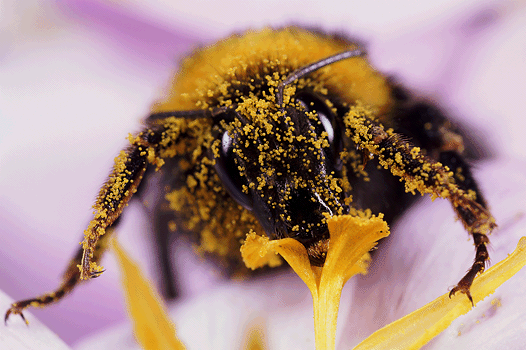January 5-11, 2012, Current Events Lesson Plan
Current Event:
A previously unknown parasitic fly found in dead and dying honey bees in northern California may be a major culprit in a mysterious condition that has ravaged honey bee colonies in the United States. This condition, known as colony collapse disorder (CCD), was first detected in 2006, when beekeepers in the United States began reporting that large numbers of bees were mysteriously abandoning their hives and then dying shortly thereafter. By 2012, CCD had been blamed in the deaths of millions of honey bees.

A bee covered in pollen sips nectar from a flower. The bee will leave some of the yellow pollen grains at other flowers it visits, pollinating them. Many flowers rely on insects for pollination. © Steve Hopkin, Taxi/Getty Images
Objective:
Bees are among the most useful of all insects. Honey bees are the world’s most important pollinator. They pollinate $14 billion worth of crops in the United States alone each year, including almonds, apples, cherries, kiwi fruit, melons, peaches, pears, raspberries, soybeans, and strawberries. Honey bees also produce honey, which people use as food, and beeswax, which is used in such products as adhesives, candles, and cosmetics. The Behind the Headlines news story and related World Book articles sheds light on one possible cause of a condition ravaging bee colonies in the United States and other countries: a parasitic fly that lays its eggs in the bees’ abdomen. After the bees die, newly born fly larvae crawl from the bees’ necks.
People And Places:
Vocabulary Terms:
- colony collapse disorder (CCD)
- fungus
- honey bee
- infection
- larvae
- mites
- parasite
- pesticides
- pollinate
- virus
- zombie
Discussion Topics:
1. The parasitic flyaffecting the bees, Apocephalus borealis, lays its eggs in the bees’ abdomen. Scientists have found some of the infected bees still alive but in a zombielike state. The insects were walking in circles, with no sense of direction, and soon became unable to stand up. After the bees died, newly born fly larvae crawled from their neck. Talk about the differences between a parasite and a host and explain that these types of parasites are endoparasites (they live inside their host), which differ from ectoparasites (those that live outside their hosts).
2. Parasites don’t just affect bees. Tell your students about the diseases parasites can cause–elephantiasis, malaria, river blindness, sleeping sickness, and many other diseases–and ask them if they can name any parasites that could harm humans. (Correct answers could include roundworms and flatworms and those that feed on blood, which include leeches, mosquitoes, and ticks.)
3. There are about 20,000 species (kinds) of bees that can be divided into two main groups–social bees and solitary bees. Social bees live in colonies, while solitary bees live alone. Most kinds of bees are solitary. Compare and contrast the different types of social bees (stingless, bumble, and honey bees) and the solitary bees (carpenter, leafcutting, mining, mason and cuckoo bees).
4. Social bees live and work together in large groups, or colonies. A typical honey bee colony is made up of one queen, tens of thousands of workers, and a few hundred drones. Ask your students to define the main roles for each type of bee. (The queen is the female honey bee that lays eggs. The workers are the unmated female offspring of the queen. The drones are the male offspring.)
5. The parasitic fly affecting the bees lays its eggs in the bees’ abdomen. Several days later, the infected bees fly from their hives at night. Scientists aren’t sure whether the bees are leaving their hives under the control of the parasite or are being kicked out by their hive-mates, who may be sensing that something is wrong. The bees may also be leaving on their own to prevent their hive-mates from becoming infested. Open a discussion about how some parasites are known for their ability to control the behavior of the creatures they infest and make them more reckless. For example, Dicrocoelium dendriticum influences the behavior of infected ants. At night, an infected ant will climb to the top of a blade of grass, where it is more likely to be eaten by cattle. Uninfected ants tend to remain on the ground, or they return to their nest.


